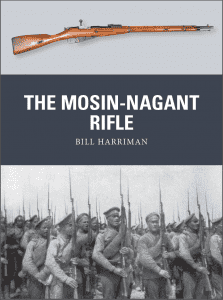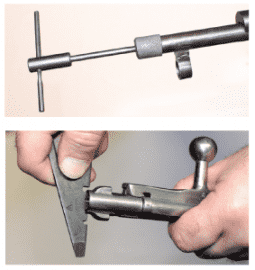 To learn more, visit https://ospreypublishing.com/the-mosin-nagant-rifle.
To learn more, visit https://ospreypublishing.com/the-mosin-nagant-rifle.
To purchase a Mosin-Nagant on GunsAmerica.com, click this link: https://www.gunsamerica.com/Search.aspx?T=mosin.
Editor’s Note: This piece was written by Bill Harriman, author of the book The Mosin-Nagant Rifle. If you would like to explore the story of the Mosin-Nagant rifle in greater detail, you can obtain a copy of the book from Osprey Publishing. The $20 for a paperback copy, or $11.99 for an eBook.
For all that talk that Mosin-Nagants are ‘no-frills’ rifles of almost agricultural construction and simplicity, they have remarkably sophisticated cleaning kits. The barrel is cleaned with the under-barrel rod, which has a tubular collar slipped over the bottom on the end. The short drift becomes a tommy bar which passes through the holes to form a gripping handle. In order to protect the muzzle crown when cleaning, the muzzle protector provides a central hole to guide the rod. The rod is pushed through the hole before the jag or brush is screwed on. The jag or brush can be tightened by using the large notch on the screwdriver which engages with flats machined onto these items.
The bore is first brushed out and then swabbed with oakum, hemp or tow soaked in solvent. An official poster showed this material wrapped around the jag in a figure of eight. When the cleaning material runs out clean, the bore is oiled.

A typical cleaning kit for Mosin-Nagants, including canvas pouch with tape closer, stamped-steel combination tool, oil/alkali solution bottle, rod collar, brush, jag, muzzle guide and tommy bar. (Author’s Collection)
The Russians clearly intended that the soldier should dismantle the bolt completely for cleaning, which is why the screwdriver had notches to indicate correct firing-pin protrusion when the bolt was reassembled. The screwdrivers are often marked with the numerals ‘75’ and ‘95’ by way of indicating the protrusion depths. The striker should touch the ‘75’ mark but should not exceed the ‘95’ mark.
The bolt-connector bar was designed to be used as a spanner on the striker shank when adjusting firing-pin protrusion. Screwdrivers had reversible blades of different widths and were made with both squared and rounded wooden handles. Some rare specimens were made from knurled steel tubing and contained part of the cleaning kit as well as doubling as a handle for the rod. These examples appear to be restricted to the 1930s and the early years of the Great Patriotic War. Later examples were made from stamped steel sheet with a large teardrop-shaped cut-out. This cut-out was to save steel while maintaining strength and did not function as a wrench or other type of implement. These later screwdrivers are often marked with an arsenal stamp denoting where they were made. Larger, but simpler, versions of the screwdriver had only the notch for unscrewing the firing pin or tightening tools onto the rod.

ABOVE Cleaning tools in use. The rod collar, muzzle guide and tommy bar are assembled and fitted to the rod. BELOW The combination tool in use. Here, its notches are used to check the depth of the striker protrusion. (Author’s Collection)
Mosin-Nagants not in regular use were to be cleaned not less than once every seven days. Otherwise, they were to be cleaned after guard duty or training, especially if blank cartridges had been used. After field firing on a range the bore and bolt head were to be cleaned and oiled immediately on the range and then the rest of the rifle thoroughly cleaned upon return to barracks. The rifle was to be checked for corrosion daily over the next three or four days. In combat or prolonged field exercises the rifle was to be cleaned daily, taking advantage of lulls in battle or exercise.
In winter, Lubricant No. 21, a thick, light-yellow grease-like petroleum jelly, was used to counteract low temperatures which led to jams and caused oils to freeze. A variety of alkaline solvents were issued, depending on the availability of the ingredients needed to make them. Their essential property was that they neutralized the acid engendered by the combustion of the propellant, which caused rust in the bore.

Russian unit armourers working on M1891 rifles. The sophisticated nature of the cleaning kit and its accompanying combination tool made the Russian soldier as self-sufficient as possible. (Nik Cornish at www.stavka.org.uk)
Loading & Firing
Before firing any Mosin-Nagant rifle or carbine, it is as well to have it checked over by a competent gunsmith who can attest to its material soundness and safety to use. Wipe any excess oil or storage grease from the bore; the patch should emerge clean and dry once all the oil has been wiped out. Ammunition for Mosin-Nagant rifles is cheap and plentiful. Ex-Soviet ammunition (packed in 440-round ‘sardine’ cans) is readily available, but most such ammunition is steel cased and Berdan primed, and it cannot be reloaded easily. Many of today’s ammunition companies load the 7.62x54mmR cartridge, but their ammunition is more expensive. Modern commercial cartridges are made with Boxer-primed brass cases which may be reloaded. If the rifle is to be used to hunt, ethical practice demands that cartridges loaded with soft- or hollow-point bullets be used.

To load with a charger, press it into the charger guide until it stops. Then, with your little finger, lift up cartridges two to five while pressing the whole stack down with your thumb. All the cartridges will be loaded into the magazine in one go. Pull the charger out of the guides and push the bolt forwards to chamber the first cartridge. (Unlike the Mauser series of rifles, the charger has to be removed by hand and does not fall away when the bolt is worked.) The safety is awkward, and its application and disengagement should be rehearsed by dry runs on an empty chamber or dummy cartridge until the technique for using it is mastered. To apply the safety, grasp the bolt-cocking piece in your right hand. Pull the cocking piece back slightly and turn the bolt anticlockwise through about 30 degrees. The cocking piece latches onto the left rear of the receiver and the rifle cannot be fired as the cocking piece and firing pin are now locked in place. To disengage the safety, pull back on the cocking piece again, turn the bolt clockwise and allow the cocking piece to run forwards until the sear engages. The rifle is now ready to fire.
 After firing with ex-Soviet military-surplus ammunition, it is essential to wipe the bore thoroughly with an ammonia-based household cleaner to neutralize the corrosive residue from the Soviet mercuric primers. Modern ammunition is far less corrosive, but careful cleaning is always needed. The bore should also be wiped out with a proprietary bore solvent and preserved for storage with light machine oil.
After firing with ex-Soviet military-surplus ammunition, it is essential to wipe the bore thoroughly with an ammonia-based household cleaner to neutralize the corrosive residue from the Soviet mercuric primers. Modern ammunition is far less corrosive, but careful cleaning is always needed. The bore should also be wiped out with a proprietary bore solvent and preserved for storage with light machine oil.
Editor’s Note: This piece was written by Bill Harriman, author of the book The Mosin-Nagant Rifle. If you would like to explore the story of the Mosin-Nagant rifle in greater detail, you can obtain a copy of the book from Osprey Publishing. The $20 for a paperback copy, or $11.99 for an eBook.
To learn more, visit https://ospreypublishing.com/the-mosin-nagant-rifle.
To purchase a Mosin-Nagant on GunsAmerica.com, click this link: https://www.gunsamerica.com/Search.aspx?T=mosin.

These are cool guns and scream history.
The m44 is my favorite if I had to use one to fight.I’d keep the bayonet in the deployed position. Only folding it when I stored the rifle. This’ll ruffle feathers but I’d prefer a m44 over a ar15/m16 for a survival situation.
Referring to one of the tools commonly included in a Mosin cleaning kit, you state: “Later examples were made from stamped steel sheet with a large teardrop-shaped cut-out. This cut-out was to save steel while maintaining strength and did not function as a wrench or other type of implement.” However, I vaguely recall that “large teardrop-shaped cut-out” being amazingly effective at supplying just the right amount of additional leverage to twist the bayonet on or off the rifle. Perhaps this was just another example of “necessity being the mother of invention”.
It’s water that gets out the salts not the ammonia. The ammonia dissolves copper and powder fouling residues.
Never Dull metal polish, available in the automotive section at Walmart is a great way to clean your bore. It will leave your bore shiny and pristine. May require a little elbow grease however.